Old gardens underpin new science
Words and images supplied By John Fitzsimmons
Botanic gardens are museums of living plants where botanists and horticulturists work together. Understandably, many of the world’s oldest and most respected botanic gardens began in association with places of learning – universities, churches, and under the patronage of wealthy benefactors. One of the earliest began in Tübingen, Germany, which remains relevant and valuable today.
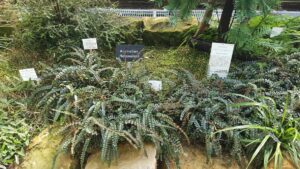
The idea of botanic gardens is said to have originated in Europe, especially in Italy, during the Renaissance in the 1500s. At this time there was a surge in thinking resulting in significant innovation in the arts, architecture, and science – including medicine and botany. The gardens led to more widespread collection, descriptions and understanding of plants, especially their structure and physiology. The idea spread across Europe, and beyond to Asia by the 1700s.
Because many medicines, medical remedies and treatments were herbal-based at that time, there was often a close association between the medical fraternity and such plant collections. Such was the case in Tübingen on the Neckar River in southern Germany. There the Eberhard Karls University of Tübingen was established in 1477 by Count Eberhard IV. He was inspired by the Renaissance after travels to Italy.
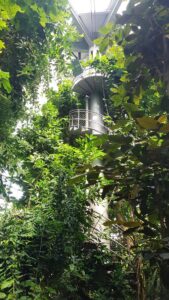
While becoming well known for studies in the fields of theology and philosophy, the University of Tübingen was the first in Germany to establish a faculty of natural sciences (1863). More recently, it has been recognised for work in law, archaeology, artificial intelligence … and plant biology!
Leonhart Fuchs
Physician Leonhart Fuchs was born in Bavaria in 1501. Something of a prodigy, he went to grammar school and was later admitted to the University of Erfurt by age 11, and qualified as a medical doctor by age 23. In 1533 he was asked to go to the University of Tübingen by the Duke of Wurttemberg.
Just two years later, when the university and Fuchs’ lodgings were in the old town, he initiated its first apothecary (medicinal) garden near the nuns’ house, to complement his medical studies.
Academically, Fuchs supported a return to the herbal-based ‘simples’ medications of the ancient Greeks, rather than the ‘compounds’ favoured in the Middle Ages. In demonstrating medicinal plants in the garden he also imparted practical horticultural experience to students.

While Fuchs published more than 50 works, mostly medical, his major contribution to our greenlife knowledge was the publication of De Historia Stirpium Commentarii Insignes (in Latin) in 1542. This large book was notable for the detail and accuracy of its graphic woodcut illustrations of nearly 500 plant species, of which more than 100 were newly recognised.
The plants in Fuchs’ publication were not ordered according to any particular classification; however the quality of the illustrations highlighted the link between named plants and visual recognition.
Fuchs’ standing in botanical circles was subsequently honoured in naming the genus Fuchsia (see separate article March issue of Hort Journal Australia).
Old Garden
The garden’s location changed several times, but in 1804 Duke Friedrich ordered new gardens be constructed on the banks of the Ammer, a small tributary of the Neckar running through the old town. After three years of work, this was completed in 1809. Four greenhouses were built and an arboretum planted among other features. A stone and glass glasshouse were added in 1839, replaced by a new steel-framed and glass structure, the ‘palm house’, later that century. A tank for aquatic plants was also installed later.
The ‘Old Garden’ was ultimately given up by the university, which transformed it into a city park. Despite numerous controversial civil protests, the surviving palm house was demolished.
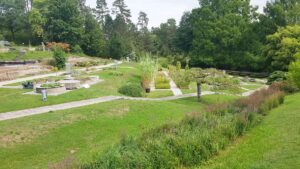
New Garden
In 1968 the extensive New Botanic Garden was opened as part of the Botanical Institute on the Morgenstelle (morning star) high point just north west of Tübingen’s old town, in 1970. The University’s modern faculties of Mathematics and Natural Sciences, with the departments of Biology, Chemistry, Pharmacy, Mathematics and Physics, as well as a branch of the University Library of Tübingen, are also on this prominence 450 metres above the old town centre.
The new garden includes greenhouses, a tropicarium, outdoor facilities and an arboretum.
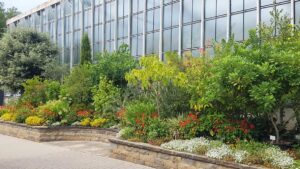
It covers some 10 hectares overall and hosts more than 10,000 plants from five continents (including Australia!). The arboretum covers about half of the garden’s area; a feature is a collection of more than 100 apple cultivars, some described as ‘rare’.
There are five specialist greenhouses: a tropicarium, a succulent house, a sub-tropical house, aquariums, and vegetation of the Canary Islands (from 1987).
The tropicarium alone, an architectural landmark, occupies 2800 square metres and is as high as 15 metres inside. It has broadly three sections:
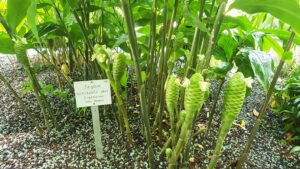
- Tropical crops and plants
- Tropical ferns
- Tropical rainforest: This is the largest area and includes the rest of the house. The area is geographically divided between species of the New World and the Old World.
The succulents greenhouse is divided into geographical sections:
- Plants from the New World (North and South America), amongst them many cacti (Cactaceae) and agaves (Asparagaceae).
- Plants from the Old World, among them plants that on first sight seem like cacti – representatives of Euphorbiaceae- in appearance they seem similar to cacti. They represent, on the African continent, a similar ecological niche as cacti in America, and have evolved similar appearances (convergent evolution). There are also some old palm ferns (Cycadaceae), transferred in 1969 from the old gardens.
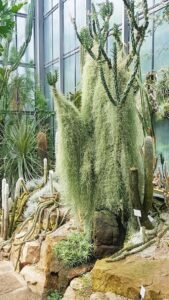
At the entrance to the greenhouses is a display case containing some special South American cacti since 2016 – Copiapoa and Sulcorebutia.
In the sub-tropical house, plants from higher altitudes in the tropics are housed, and divided geographically. The focus is on Fuchsia and Begonia, as well as tree ferns and plants from Australia.
The University of Tübingen Botanical Garden has a remarkable collection of fuchsias plus some ‘false fuchsias’ whose flowers resemble fuchsia flowers but are not related to fuchsias, despite the apparent similarity.
The extensive outside displays include a Rhododendron valley, primrose valley, and fern gorge well-sited in a steep gully, a heath area, moss trail, and a steppe area featuring Asian and North American shrubs.
A special area is devoted to the regional Swabian Alb, a 200km long and 1000m high mountain range between the Neckar and Danube Rivers, of which the Tübingen collection includes many already endangered species. Here the differences between the Botanic Garden’s collection and plant species still in situ have been researched and tracked to reveal ‘genetic drift’ in the wild populations not reflected in the curated collection. This integration of the Garden’s utility and benefits with the university’s research programs is of significant value in considering climate change and land management.

There is also an alpine garden and greenhouse representing different geographical and ecological areas.
Tübingen is famous for its hills, especially the steep gradients (especially by our standards). With the modern University buildings prominent over the old medieval town, the situation is remarkable. The new Botanic Garden, high on the slope, takes great advantage of the topography to create numerous microclimates as well as visual impacts. With its centuries-old academic heritage links it really does present botanical interest in four dimensions.
Main photo: Architectural landmark – the Tropicarium at University of Tübingen Botanic Garden

